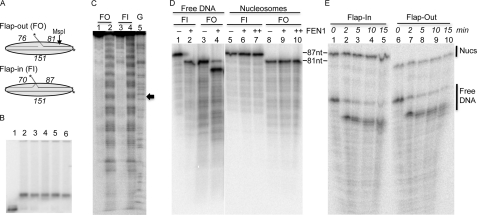FIGURE 7.
Flaps in 601 nucleosomes are refractory to FEN1, regardless of orientation. A, schematic of DNA oligonucleotides used to assemble the 601 151-bp flap-out (FO) and flap-in (FI) substrates. The length of the ligated oligos used to anneal each template are indicated in italics. The location of the flaps and the MspI cleavage site are indicated. B, translational gel analysis of 601 nucleosomes reconstituted with flap-out (lanes 2 and 4), flap-in (lanes 3 and 5), and control (no flap, lane 6) DNA fragments. Naked DNA is shown in lane 1. C, flap-containing 601 nucleosomes exhibit expected rotational orientation. FO and FI 601 nucleosomes were either mock-treated (lanes 1 and 3) or treated with hydroxyl radicals, and the cleavage patterns were analyzed by sequencing gel electrophoresis. The position of radioactive labels is on the 151-nt bottom strands, as indicated by the asterisk in A. The predicted location of the nucleosome dyad is indicated by the filled arrow. D, FEN1 cleavage of 601 DNA (lanes 1–4) and nucleosomes (lanes 5–10). FI and FO substrates were incubated in the absence (lanes 1, 3, 5, and 8) or presence (lanes 2, 4, 6, and 9) of FEN1 for 15 min. The samples in lanes 7 and 10 were incubated with FEN1 for 30 min. Cleavage was analyzed on 6% sequencing gels as described above. The full-length substrate and cleaved product are 86 and 81 nt, respectively. E, cleavage of 601 FI and FO nucleosomes and naked DNA substrates incubated in the same reaction. Naked 601 FI and FO DNA was truncated by cleavage with MspI (see A), mixed with an equivalent amount of FI and FO 601 nucleosomes, and then incubated together with FEN1 in the same reaction. Lanes 1 and 6 show undigested samples, whereas lanes 2–5 and 7-10 show samples digested with FEN1 for the times indicated above the gel. The positions of uncleaved nucleosome DNA and uncleaved and cleaved naked DNA are indicated.

